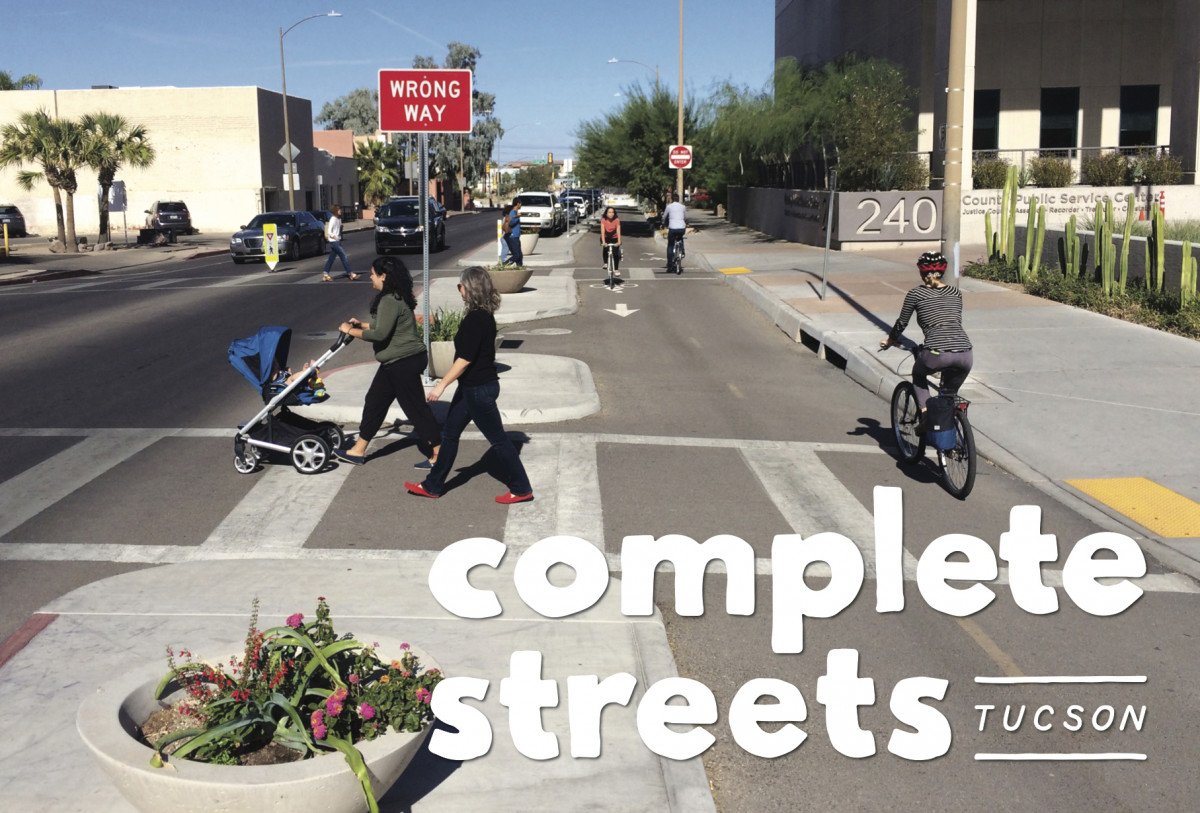Three years later: the impact of Tucson’s Complete Streets policy
[Photo: An example of a Complete Street in Downtown Tucson. There are three people riding their bicycles in a protected bike lane. Five different people are making use of large cross walks. There are planters filled with native plants to provide beauty along with the tree lined streets offering shade.]
February 5th marks the three-year anniversary of Tucson’s Complete Streets policy. Over the past three years, from our policy makers to journalists, we have witnessed more and more people embracing the concept and referencing “Complete Streets.” The term has also often been invoked in the midst of our recent local and regional discussions about transportation. Perhaps you have a vague idea of what this means. But what exactly are Complete Streets? That’s the exciting and nebulous part of it –Complete Streets are whatever the people need in their surrounding environment.
And that is the core of Complete Streets: people. People on foot, people in wheelchairs, people riding bikes, people using transit and, yes, people driving cars. All of these people require and deserve space designated for their safe movement through a neighborhood, district, and city. Complete Streets is a way of designing and building our streets that focuses on creating a safe and welcoming experience for all people regardless of who they are and how they travel. Therefore, it’s more of a design approach and philosophy, rather than a prescribed one-size-fits-all formula.
See a sidewalk and a bike lane? That still might not be a Complete Street. Smart Growth America notes that “we continue to design and operate streets that prioritize the speedy movement of vehicles at the expense of safety for all people who use them.” Everyone, even people who use cars as a primary mode of transportation, should advocate for a change. Smart Growth America goes on to say, “these street design practices can also set drivers up to fail by making mistakes easier and the consequences of them more deadly, even when following the rules.” Beyond the negative implications of an “incomplete street,” Complete Streets are an acknowledgement that where we live and how our neighborhoods are structured contribute to individual health and well-being. Complete Streets cultivate outdoor activity, interpersonal connections, and thriving businesses. Complete Streets promote transportation equity and value the unique sense of place we create in our local spaces.
The City of Tucson adopted a Complete Streets policy in February 2019, showing that vibrant cities don’t just accommodate people, but celebrate the uniqueness of all the individuals within them. Living Streets Alliance led the community visioning and drafting of that policy from 2016-2018, and continues to advocate for the recommitment to that policy in transportation decisions being made every day. Join Living Streets Alliance in creating more vibrant streets in your neighborhood and throughout the city!
How can you act?
There are open seats on the Complete Streets Coordinating Council. Help shape Tucson's transportation future by applying to be a member! If you live in Ward 5, contact the Ward 5 council office and let them know you're interested. If you live elsewhere in the City of Tucson, fill out this application form.
Sign up for our Advocacy Alerts to know when big decisions are being made and how to make your voice heard
Get together with your neighbors to complete a Walkability Assessment to start advocating for Complete Streets in your neighborhood
Stay engaged at the national level to advocate for earmarked federal funding
Donate to Living Streets Alliance and support the local advocacy work we do every day
Living Streets Alliance worked closely with the City of Tucson Dept. of Transportation & Mobility to develop a policy rooted in community need and vision. To this end, LSA spearheaded a variety of strategies to bring different voices to the table and provide multiple access points for engaging in the conversation about Complete Streets in Tucson. The following are key tactics utilized in the Complete Streets policy development process, many of which can also be found in our Complete Streets Community Engagement Toolkit that we created to help guide other communities as they develop their own complete streets policies.


